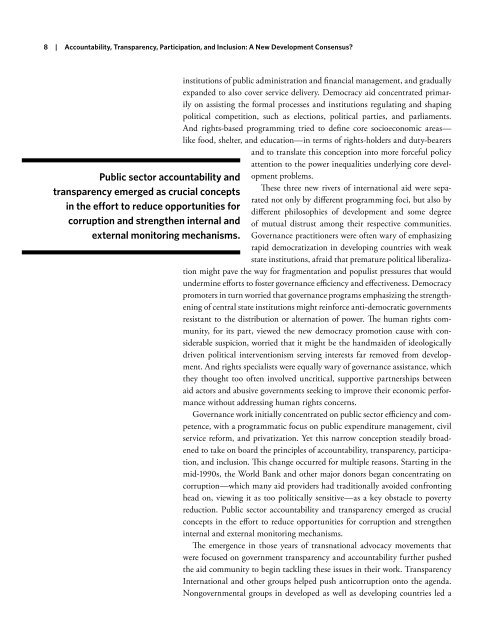Accountability
Accountability
Accountability
Create successful ePaper yourself
Turn your PDF publications into a flip-book with our unique Google optimized e-Paper software.
8 | <strong>Accountability</strong>, Transparency, Participation, and Inclusion: A New Development Consensus?<br />
institutions of public administration and financial management, and gradually<br />
expanded to also cover service delivery. Democracy aid concentrated primarily<br />
on assisting the formal processes and institutions regulating and shaping<br />
political competition, such as elections, political parties, and parliaments.<br />
And rights-based programming tried to define core socioeconomic areas—<br />
like food, shelter, and education—in terms of rights-holders and duty-bearers<br />
and to translate this conception into more forceful policy<br />
attention to the power inequalities underlying core development<br />
problems.<br />
Public sector accountability and<br />
These three new rivers of international aid were separated<br />
not only by different programming foci, but also by<br />
transparency emerged as crucial concepts<br />
in the effort to reduce opportunities for<br />
different philosophies of development and some degree<br />
corruption and strengthen internal and of mutual distrust among their respective communities.<br />
external monitoring mechanisms. Governance practitioners were often wary of emphasizing<br />
rapid democratization in developing countries with weak<br />
state institutions, afraid that premature political liberalization<br />
might pave the way for fragmentation and populist pressures that would<br />
undermine efforts to foster governance efficiency and effectiveness. Democracy<br />
promoters in turn worried that governance programs emphasizing the strengthening<br />
of central state institutions might reinforce anti-democratic governments<br />
resistant to the distribution or alternation of power. The human rights community,<br />
for its part, viewed the new democracy promotion cause with considerable<br />
suspicion, worried that it might be the handmaiden of ideologically<br />
driven political interventionism serving interests far removed from development.<br />
And rights specialists were equally wary of governance assistance, which<br />
they thought too often involved uncritical, supportive partnerships between<br />
aid actors and abusive governments seeking to improve their economic performance<br />
without addressing human rights concerns.<br />
Governance work initially concentrated on public sector efficiency and competence,<br />
with a programmatic focus on public expenditure management, civil<br />
service reform, and privatization. Yet this narrow conception steadily broadened<br />
to take on board the principles of accountability, transparency, participation,<br />
and inclusion. This change occurred for multiple reasons. Starting in the<br />
mid-1990s, the World Bank and other major donors began concentrating on<br />
corruption—which many aid providers had traditionally avoided confronting<br />
head on, viewing it as too politically sensitive—as a key obstacle to poverty<br />
reduction. Public sector accountability and transparency emerged as crucial<br />
concepts in the effort to reduce opportunities for corruption and strengthen<br />
internal and external monitoring mechanisms.<br />
The emergence in those years of transnational advocacy movements that<br />
were focused on government transparency and accountability further pushed<br />
the aid community to begin tackling these issues in their work. Transparency<br />
International and other groups helped push anticorruption onto the agenda.<br />
Nongovernmental groups in developed as well as developing countries led a

















